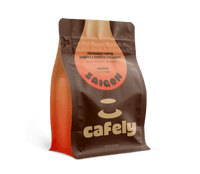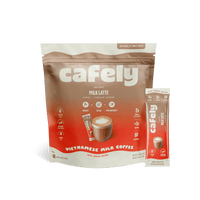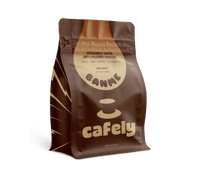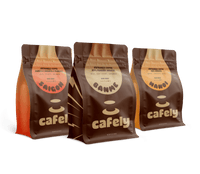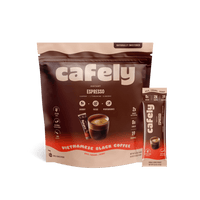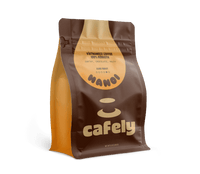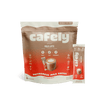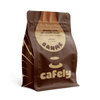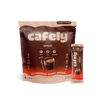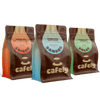Traditional iced coffee (the most common coffee style in Vietnam) is called cà phê sữa đá (pronounced kah-fey-suh-dah), but there are many other variations worth learning, too.
For example, cà phê sữa nóng refers to the same drink, only prepared hot rather than poured over ice. Cà phê espresso simply means “espresso coffee.”
Here, we’ll go over the name and pronunciation for many different types of coffee drinks in Vietnamese, along with how to pronounce them.
How to Ask for Different Kinds of Coffee in Vietnamese
Here are the 13 most common types of coffee in Vietnam and how to say each on in Vietnamese (with pronunciation):
|
English |
Vietnamese |
Pronunciation |
|
Traditional Vietnamese Coffee, Iced |
Cà phê sữa đá |
Kah-Fey-Suh-Da |
|
Traditional Vietnamese Coffee, Hot |
Cà phê sữa nóng |
Kah-Fey-Suh-Nong |
|
Black Coffee, Hot |
Cà phê đen nóng |
Kah-Fey-Dehn-Nong |
|
Black Coffee, Iced |
Cà phê đen đá |
Kah-Fey-Dehn-Dah |
|
Coffee Prepared With a Phin Filter |
Cà Phê Phin |
Kah-Feh-Feen |
|
Espresso Coffee |
Cà phê espresso |
Kah-Fey-Espresso |
|
Vietnamese Iced Latte |
Bạc xỉu đá |
Back-Sieu-Dah |
|
Egg Foam Coffee |
Cà phê trứng |
Kah-Fey-Troong |
|
Coconut Coffee, Iced |
Cà phê cốt dừa |
Kah-Fey-Cot-Dzua |
|
Yogurt Coffee |
Sữa Chua Cà Phê |
Soo-Ah-Chwah-Kah-Feh |
|
Coffee Smoothie |
Sinh Tố Cà Phê |
Sing-Toh-Kah-Feh |
|
Salted Coffee (Shakerato) |
Cà Phê Muối |
Kah-Feh-Mwoy-ee |
|
Civet (Weasel) Coffee |
Cà Phê Chồn |
Kah-Feh-Chuhn |
Hot Coffee (Nóng) vs. Iced Coffee (Đá)
Although hot coffee is the default in many countries, most baristas in Vietnam will assume you want an iced coffee if you don’t specify otherwise. Vietnam is a tropical, hot country, so iced beverages are the norm here.
Remember to add the word “nóng” to your order if you want it hot! (Cà phê nóng).
List of the Most Popular Coffee Drinks in Vietnam
There are two main iced coffee drinks with condensed milk in Vietnam: cà phê sữa đá and bạc xỉu — but you can also find all kinds of innovative recipes (such as egg foam coffee or yogurt coffee) as well as standard European preparations like lattes, cappuccinos, and espressos.
1. Cà Phê Sữa (Vietnamese Iced Coffee)

Pronunciation: Kah-feh soo-ah.
This is, by far, the most common and is a blend of robusta coffee and condensed milk. It can be served hot (cà phê sữa nóng) or poured over ice (cà phê sữa đá).
Cà phê sữa đá is the most common coffee you’ll encounter. It’s the traditional Vietnamese iced coffee many of us know and love.
2. Bạc Xỉu (Iced Latte)

Pronunciation: Bahk see-oo.
This coffee is more akin to an iced latte in Western coffee culture. It’s essentially a tall glass of ice and condensed milk with a small portion of concentrated coffee in it.
Bạc xỉu is similar to cà phê sữa but with a much higher milk-to-coffee ratio. This makes it a lot sweeter overall and a better choice if you want something less bitter or without so much caffeine.
3. Cà Phê Đen (Black Coffee)

Pronunciation: Kah-feh den.
This coffee doesn’t contain any condensed milk. It has a distinctly strong, aromatic, and bitter taste. The Vietnamese typically drink it straight, or mix in a little bit of sugar.
If you’d rather your coffee without sugar, make sure you order cà phê đen không đường (pronounced as kah-feh den kohng doo-ong).
4. Cà Phê Phin (Phin Coffee)

Pronunciation: Kah-feh feen.
Phin coffee refers to coffee made using a traditional tool called a phin filter. It's a small immersion-brewing device invented in Vietnam. Its simple design is easy and cheap to build. Phin works perfectly in preparing Vietnamese-style coffees with bold flavors and a powerful caffeine kick.
5. Cà Phê Trứng (Egg Coffee)

Pronunciation: Kah-feh troong.
Vietnamese egg coffee might sound a little strange, but it’s surprisingly delicious. This coffee is first brewed using a traditional phin filter. This is then combined with egg yolks and condensed milk that have been whipped together to create a deliciously sweet and silky foam.
Cà phê trứng is normally served as a dessert after meals.
6. Sữa Chua Cà Phê (Yogurt Coffee)

Pronunciation: Soo-ah chwah kah-feh.
Yogurt coffee is another delightful dessert-style coffee drink prepared with dark black, almost espresso-like phin coffee, which is then mixed with a creamy Vietnamese-style yogurt (yogurt which is mixed with condensed milk).
The flavor of this coffee is similar to conventional cà phê sữa but with a unique aftertaste.
7. Sinh Tố Cà Phê (Coffee Smoothie)

Pronunciation: Sing toh kah-feh.
Coffee smoothies are prepared by blending strong black coffee (usually prepared with a phin filter or espresso) with various tropical fruits, ice, and condensed milk.
The most popular form is called sinh cà phê chuối bơ (pronounced singkah-feh chwee-oy boh) — which includes banana and avocado.
Cà phê sầu riêng (pronounced kah-feh soo-ah ree-eng) is another popular smoothie recipe, which is made with sapodilla and tropical fruits.
8. Cà Phê Muối (Salted Coffee)

Pronunciation: Kah-feh mwoy-ee.
Salted Vietnamese coffee (AKA "Shakerato Coffee") follows the same recipe as cà phê sữa (traditional Vietnamese coffee) — strong black coffee and condensed milk served either hot or cold. The difference is that a small amount of salted cream or sea salt is used to further enhance the flavor.
9. Cà Phê Chồn (Civet Coffee)

Pronunciation: Kah-feh chuhn.
Civet coffee (AKA: kopi luak coffee or weasel coffee) refers to any coffee beans that have been eaten and excreted by a cat-like animal called the Asian Palm Civet (Paradoxurus hermaphroditus) prior to roasting.
There’s a lot of debate around whether this process enhances or degrades the flavor of the coffee, but this style of beans is some of the most expensive coffee you can buy.
After the beans are eaten by the civet, it passes through its digestive tract completely intact. The beans themselves cannot be broken down and are collected from the animal's feces. The beans are then thoroughly washed and roasted.
Cà Phê Chồn tends to have a more earthy, fruity, and chocolatey flavor than regular coffee.
10. Cà Phê Cốt Dừa (Coconut Coffee)

Pronunciation: Kah-fey-cot-dzua.
Cà Phê Cốt Dừa, simply put, is Vietnamese coconut coffee. It is another common drink that requires heating full-fat coconut milk with sweetened condensed milk and adding it to the coffee.
Related: How to Make Delicious Vietnamese Coconut Coffee At Home
11. Cà Phê Espresso (Espresso Coffee)

Pronunciation: Kah-feh eh-spres-oh.
This coffee refers to conventional European-style espresso coffee. It’s made using an espresso machine rather than with a phin filter.
You can also ask for any of the standard coffees you’re used to at home by adding cà phê before it. For example cà phê latte for lattes, cà phê cappuccino for cappuccinos, or cà phê macchiato for machiatos.
Where Does the Vietnamese Word for Coffee Come from?
As with most things to do with cafe culture in Vietnam, the Vietnamese word for coffee comes from French colonialism. It’s hard to ignore the phonetic similarities between cà phê and café.
It's really common in Vietnam to see coffee spelled as 'cafe' instead of cà phê as a remnant of French colonialism. The French colonized Vietnam from 1858 to 1954. Their influence lives on in much of the coffee culture here. Words like bơ (butter) and sô-cô-la (chocolate) are also rooted in French.
Other words, like coconut ("dừa"), sugar ("đường"), and lime ("chanh") come from the Vietnamese language.
Related: Vietnamese Coffee's History
FAQs: Vietnamese Coffee
So now that you know how to ask for coffee in Vietnamese, let's finish off with some quick, frequently asked questions about ordering coffee in Vietnam.
1. What is phin sua da?
Phin sua da is Vietnamese iced coffee with milk brewed the traditional way. The ‘phin’ part comes from the phin filter that brews the strong coffee like Vietnamese coffee. It’s also known as just cà phê sữa đá, but if a sign says phin sua da, then it’s guaranteed to be made using a phin filter.
2. What is café sua nong?
Cà phê sữa nóng, or café sua nong, is another name given to strong, hot Vietnamese coffee. Traditionally, a robusta dark roast is used, like our HaNoi beans. It’s made with a phin filter and then mixed with sweetened condensed milk. It’s one of the most common types of coffee you’ll to find in Vietnam.
3. What is a Vietnamese coffee?
Vietnamese coffee is a short, strong, and sweet style of coffee made with highly caffeinated dark roast robusta beans and thick, sweetened condensed milk. Usually, this is made using a phin filter, giving it a strong but smooth flavor profile. The sweetened condensed milk balances out the bitter coffee, which can often be an acquired taste for some.
4. How do you say ‘I would like’ in Vietnamese?
If you’re ordering anything in Vietnam, you’ll need to know the key anchor phrase “I would like.”
In Vietnamese, this is ‘tôi muốn‘ (toy-mon). This is fairly formal, so you can also say ‘làm ơn cho tôi cái này’ (lahm-ohn-choi-toy-cah-nay), which means, “Please give me that one.”
Although it sounds more abrupt, it can be more useful if you don’t know the name of the item.
Always include ‘làm ơn’ (lahm-ohn), as this means “Please;” otherwise you might come off as rude.
